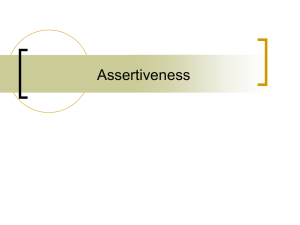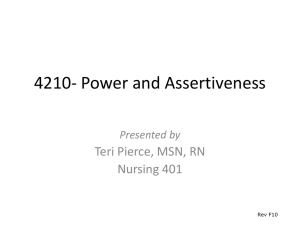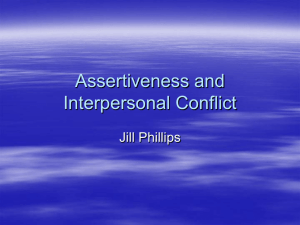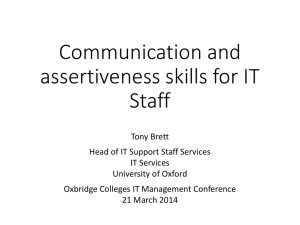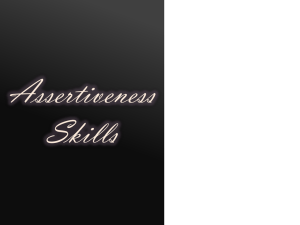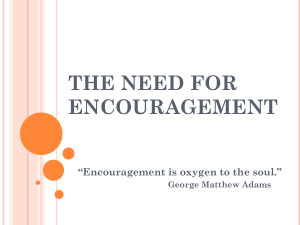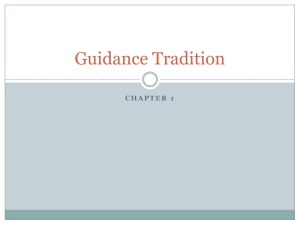Conscious Discipline
advertisement
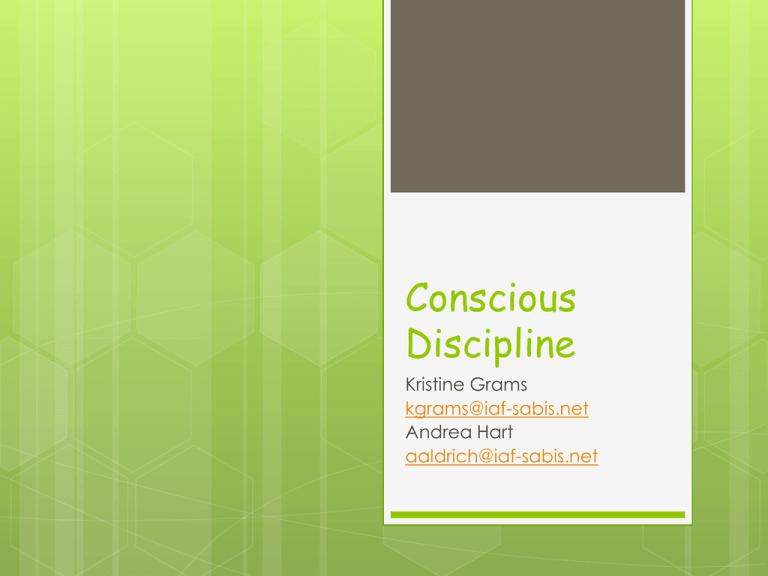
Conscious Discipline Kristine Grams kgrams@iaf-sabis.net Andrea Hart aaldrich@iaf-sabis.net What is Conscious Discipline? A comprehensive social and emotional intelligence classroom management program that empowers BOTH teachers and students Based in current brain research/child development and developmentally appropriate practices http://consciousdiscipline.com/about/bra in_state_model.asp What is Conscious Discipline? Promotes: permanent behavior changes in both teacher and students Goal: provide systematic change in schools - change from traditional compliance model of discipline to a relationshipbased community model What is Conscious Discipline? Traditional model looks like: - Rule based - upheld by consequences - in order to obtain obedience - compliance earns rewards - disobedience earns punishment - persistent disobedience means removal Tool used in this model: FEAR Premises traditional model is based on: - It is possible to control others - Rules govern behaviors - Conflict is a disruption of the learning process What is Conscious Discipline? So why change?! - Brain research indicates fear is detrimental to optimal learning and brain development. - Both teachers AND students are empowered - Before we can change student behaviors, we must first change ourselves What is Conscious Discipline? This program empowers teachers with 7 Powers for Self Control: 1. 2. 3. 4. 5. 6. 7. Power of Perception: No one can make you mad without your permission Power of Unity: We’re all in it together Power of Attention: What you focus on, you get more of Power of Free Will: The only person you can make change is yourself Power of Love: See the best in others Power of Acceptance: The moment is what is it Power of Intention: conflict is an opportunity to teach What is Conscious Discipline? Teaches 7 Basic Skills of Discipline 1. Composure: become the person you want children to be 2. Encouragement: build school family 3. Assertiveness: saying “no” and being heard 4. Choice: build self-esteem and willpower 5. Positive Intent: creating teaching moments 6. Empathy: handing the fussing and fits 7. Consequences: helping students learn from their mistakes What is Conscious Discipline? Creates classroom climate that models 7 Essential Life Values 1. Integrity 2. Interdependence 3. Respect 4. Empowerment 5. Diversity 6. Compassion 7. Responsibility What is Conscious Discipline? Teaches Students Basic Social Skills 1. Anger Management 2. Helpfulness 3. Assertiveness 4. Impulse Control 5. Cooperation 6. Empathy 7. Problem Solving Becoming Brain Smart Three Brain States 1. Survival State- takes place in the brainstem 2. Emotional State- takes place in the limbic system 3. Executive State- takes place in the prefrontal lobes *This is where we want our students to be!* Composure Principle 1: Composure is self control in action. It is a prerequisite skill adults need before disciplining children. - Self Control is: being aware of your own thoughts and feelings - Without Self Control you may be turning your life, and power, over to people, events, and things. For example: - “You make me so mad!” - “Look what you made me do!” - Self-Control must be priority #1 “When you lose self-control, you lose the ability to discipline yourself or your children. Composure Out of control adults: Focus on what they don’t want to happen. “STOP!” See things from only their own point of view “You broke the rule!” Would rather punish than teach “Go to the office!” Composure Principle #2: Healthy, secure relationships require that we control our own upsets. No one can make us angry without our permission. - Whomever you have placed in charge of your feelings, you have place in control of you. - Upset is not caused by another person, it is triggered by another person “We see the world not as it is, but through the lens of our judgments about what is desirable.” Composure Triggers Categories: 1. Assumed Intent 2. Magnification 3. Labeling Skill #1: Changing trigger thoughts to calming thoughts. - 2 ways to change: 1. Calming self-talk 2. Refute the trigger thoughts Composure Principle #3: Start the day the Brain Smart Way and implement stress redirection activities. Starting the Brain Smart Way uses activities to: 1. Unite 2. Disengage the stress 3. Connect students to teacher and each other. 4. Commit themselves to learning Composure Brain Smart Start - Unity activities bring everyone together. pledge, song - Disengage the stress activities involve deep breathing and stretching. pretzel, balloon, rollercoaster - Connecting activities pull people together through touch or eye contact handshakes, waving hello - Commitment/ affirmation activities help tap the power of positive thinking daily commitments Composure Skill #2: Reduce Stress 3 Skills of stress reduction are: - being able to relax - being able to focus - being able to breathe Composure Relaxation techniques: - drain - pretzel - balloon - stretching Focus techniques - saying hello - feeling the heartbeat - body tune up Activities to Breathe - belly breathing - be a STAR Composure Principle #4: Your job is to keep the classroom safe so children can learn. The child’s job is to help keep it safe. “My job is to keep you safe. Your job is to help keep it safe.” - Structure: Safe Place inside.osceola.k12.fl.us tottreasuresnorthbay.blogspot.com Encouragement Principle #1: We are ALL in this together. Old way of thinking: - one size fits all - change occurs through getting other to comply - students who do not adhere to rules can be removed without damage to the whole “Cooperation, not competition, is the cornerstone of evolution.” “Classrooms an schools need to embrace community…” “Schools must think of themselves school families…” Encouragement School Climate: the mood or feel of the school 4 key factors that lend to the school climate 1. Physical Environment (looks, smells, feels like…) 2. Social Environment (heath of relationships and interactions) 3. School Routines, Rituals, and Rules (what creates “order”) 4. Expectations (belief about how people learn and change) Encouragement Routines and Rituals: The heart and soul of school climate - Routines and Rituals are NOT the same Routines: establish patterns, add predictability, help regulate, set expectations - Create routines for as many tasks as possible (attendance, lunch count, snack, transitions, lining up, arrival, dismissal, hygiene- tissues, hand washing, using the restroom, etc) - Systematically teach routines- picture representations easy for young students to ‘read’ http://mrsriccaskindergarten. blogspot.com/2012/01/visual -directions-freebie.html handsonbibleteacher.blogspot.com http://www.sharingkindergarten.com/ thecraftrookie.blogspot.com ignitelearningllc.blogspot.com do2learn.com smilinginsecondgrade.blogspot.com Encouragement Rituals: Have connections as their goal - Most important to creating the school family - produce a calming affect Types of Rituals: - Greeting - School Family Song - Absent child - New Student/Student moving away - Holdays/birthdays Encouragement School Family Structures Friends and Family Board/Book School Family Jobs Ways to be Helpful chart/book Encouragement Friends and Family Board/Book Display pictures of children and their families Helps students get to know one another Include your own family Classroom friends (principal, specialists, security, etc) School Family Job Board Each child holds a job Jobs should be meaningful and helpful to the classroom Encouragement Principle #2: Contributing to the welfare of others builds self-worth Skill #1: Meaning Jobs for all (morning message writer, greeter, kindness recorder, visitor greeter, STAR helper, etc) Skill #2: Service jobs for a school community(keeping playground and school clean, cheering on others, etc) Encouragement Skill #3: Noticing children’s contributions to others. Notice strengths- ask students to share their strengths. Avoid ones that describe the strength as being special. Make student strengths public Basic Formula: “You ________ so _________. That was helpful!” Steps for Noticing 1. 2. 3. 4. “You…. Describe what child did Relate how child’s behavior was helpful End by saying, “That was helpful!” Encouragement Principle #3: How you “see” others defines who you are. The manner in which you perceive others defines who you are. What do you see? Teacher A – “sees” a child off task. Says “What should you be doing?” Teacher B – “sees a child who need helps focusing. Says “What would help you to focus or…” Encouragement Skill #4: The “call for help” perceptual frame. Teachers play a significant role in how children perceive each other and view misbehaviors. We can teach them that: - Inappropriate behavior is bad and needs rejection. - Inappropriate behaviors are a call for help Labeling a child ‘bad’ – 1 step process - Step 1: deliver perscribed consequence Call for help – 2 step teaching process - - Step 1: empower students to respond. *Go to the victim first!* Step 2: Use a “call for help” perceptual face. *Ask what helps the student could use. Encouragement Principle #4: We are all unique, not special. Specialness prevents people from feeling connected to one another. Principle #5: Some forms of praise can be discouraging. Effective praise relies on describing, not judging Encouragement Ways praise can be discouraging: Too general Relies on value judgments Focus on how you feel or think teachings a child to seek approval For only successful/completed tasks; effort doesn’t matter Noticing children instead of judging: Start with “You…” Describe exactly what you see End descriptive with a tag Praise is about forcing our judgments of who we think they should be onto our children. Encouragement is about accepting children for who they are. Encouragement Principle #6: Children need encouragement, especially when they have made poor choices. Encouragement is basically a dose of hope. People need hope to feel safe. Assertiveness Principle #1: What you focus on, you get more of! Don’t think about a purple alligator! We must tell the brain what TO do. Assertiveness Principle #2: When you are upset, you are always focused on what you DON’T want. Skill #1: Pivoting, “About face!” Skill #2: Assertiveness- adults must set limits respectfully. When you focus on what you want, assertiveness comes naturally. Many times we fail to give students information on what TO do We teach others how to treat us. Doubtful/unsure: invites others to boss and ‘help’ Assertiveness: lets us set boundaries to say no when appropriate Assertiveness Goal: to teach that speaking is more powerful than attacking verbally or physically You have a right and responsibility to say “No!” Saying things like “I’m waiting!” or “Line up at the door, ok?” puts students in charge of the classroom- not you. Assertiveness is a learned behavior. To learn it, you must: Achieve self-awareness Monitor your own thought patterns Teach and utilize assertiveness in all relationships Assertiveness Principle #3: Passivity invites aggression, aggression begets aggression, and assertiveness dissipates aggression. Passivity: Aggression: Wants to please Longs to be perfect Fear that decisions are not the correct ones Aims to win Uses you-me accusations Speaks for others and acts as mind reader Assertiveness: Makes straightforward statements Goal is clear communication Assertiveness Assertiveness clearly tells children what to do so they may successfully meet your expectations You cannot be assertive if: You quiz others Think for others Think about what other think of you Assertive Teachers: Tell children what to do Send nonverbal messages “just do it” with tone Are clear and direct Give children usable information Own and express feelings directly Speak in concrete terms Are conscious of the intent behind the communication Assertiveness Skill #3a: Assertive commands to individuals 1. 2. 3. 4. 5. At eye level, make eye contact State student’s name Verbally tell what you want them to do Touch student gently on arm Use visual cues through gesturing Skill #3b: Assertive commands to groups 1. 2. Use a signal or unifying experience to get the group’s attention Teach an auditory and verbal signal Assertiveness Skill #4: Tell and Show If students do not follow an assertive command, they are indicating they need additional support. Step 1: Give assertive command. If ignored, go to step 2. Step 2: Make eye contact (student makes contact with you) and say, “There you are!” Step 3: Say “I’m going to show you what I want you to do.” Assertiveness Skill #5: I-messages help when frustration sets in. Indirect expression of emotion attacks children. Direct expression communicates with them. I-messages are direct expressions. They: Describe the behavior Describe the feeling you are having. Describe a tangible impact of the behavior Describe a different behavior that is helpful. “I don’t like it when you _____. It ________ because ________. Please _________ instead.” “When you ________, I feel ________ because _______. Please _________.” Assertiveness Principle #4: Children must learn that they teach others how to treat them. They must learn to assertively deal with intrusive behaviors. Students tattle because they don’t know how to solve the problem. Skill #6: Tattling as a teaching tool. Passive/aggressive tattling: attempts to get revenge and punish the uncooperative person Tattling out of fear: classroom isn’t safe, do something about it! Child feels intruded upon: child feels violated and doesn’t know what to do to fix it. Assertiveness Tattling usually takes on one of three forms The child feels victimized. The child witnessed someone getting hurt. Your response: “Did you like it? Go tell ________, ‘I don’t like it when you ______.” Have them practice once or twice with you first, before sending them off. Your response: “I am the safekeeper. It’s my job to keep you safe. I’ll take care of it.” The child wants to get someone in trouble. Your response: “Are you telling me to be helpful or hurtful?” Many times the child will say helpful. Your response? “HOW is that helpful?” Have them tell you how they can be helpful instead of hurtful.
